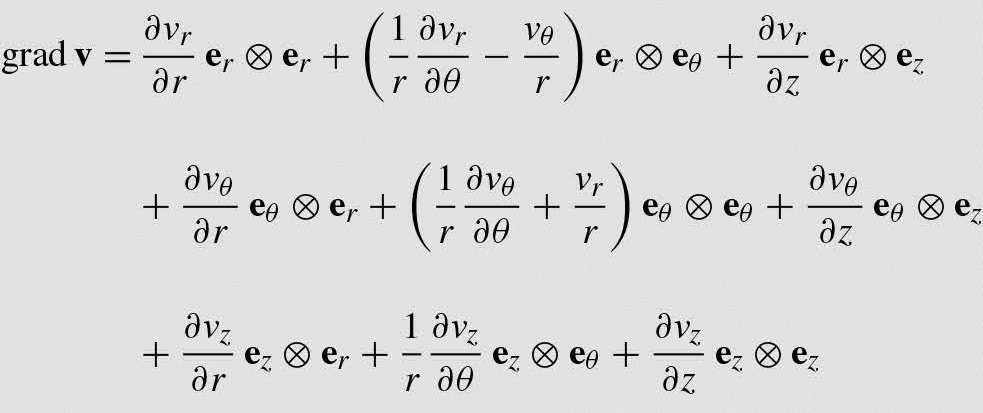2.6 Curvilinear coordinates
Recall that any basis for the three-dimensional inner product space ε3![]() has three elements. Also recall that ε3
has three elements. Also recall that ε3![]() has a fixed orthonormal basis {ei} = {e1, e2, e3}. As was demonstrated in (2.21), any vector u in ε3
has a fixed orthonormal basis {ei} = {e1, e2, e3}. As was demonstrated in (2.21), any vector u in ε3![]() can be expressed in terms of this basis, i.e.,
can be expressed in terms of this basis, i.e.,
u=u1e1+u2e2+u3e3,
or, compactly,
u=uiei.
The scalars u1, u2, and u3 are called the Cartesian components of vector u.
Of course, ε3![]() has infinitely many other fixed orthonormal bases, which are merely rotations or inversions of {e1, e2, e3}. It also has infinitely many other bases that are not orthogonal or fixed; components with respect to these bases are called non-Cartesian or curvilinear components. (Because its basis vectors {e1, e2, e3} are fixed and do not change direction or magnitude with position, Cartesian component notation is the simplest to manipulate.)
has infinitely many other fixed orthonormal bases, which are merely rotations or inversions of {e1, e2, e3}. It also has infinitely many other bases that are not orthogonal or fixed; components with respect to these bases are called non-Cartesian or curvilinear components. (Because its basis vectors {e1, e2, e3} are fixed and do not change direction or magnitude with position, Cartesian component notation is the simplest to manipulate.)
Since ε3![]() is a metric space (refer to Section 2.1.2 and Figure 2.3), the position vector x in ε3
is a metric space (refer to Section 2.1.2 and Figure 2.3), the position vector x in ε3![]() can be considered a point in space, or a vector from the origin to the point. Furthermore,
can be considered a point in space, or a vector from the origin to the point. Furthermore,
x=x1e1+x2e2+x3e3,
or, compactly,
x=xiei.
The Cartesian components xi of position vector x are called the Cartesian coordinates of the point. The three independent variables x1, x2, and x3 therefore define the position of point x in ε3![]() .
.
Since e1, e2, and e3 are fixed, the surfaces xi = constant, called the coordinate surfaces, are planes, and the intersections of two coordinate surfaces, called coordinate curves, are straight lines (see Figure 2.5). For example, the coordinate surface x1 = C = constant is a plane perpendicular to the unit vector e1, and the x1 coordinate line given by x2 = D = constant, x3 = ε = constant is a straight line in the e1 direction.

When solving boundary-value problems, one adopts coordinate systems (θ1, θ2, θ3) in which the boundary surfaces in the physical problem (where the boundary values are specified) are given by coordinate surfaces θi = constant. Because the coordinate surfaces are planes, Cartesian coordinates are useful for solving boundary-value problems in situations where the boundary surfaces are planes. However, in many problems of interest, the boundary surfaces are not planes, and it is therefore advantageous to adopt curvilinear coordinates.
Since the coordinate surfaces θi = constant in curvilinear coordinate systems are not planar, the coordinate curves (given by the intersection of two coordinate surfaces) are not straight lines. The basis vectors, which are tangent to the coordinate curves, are not fixed, but rather rotate in space with change of position. (Curvilinear coordinates are so called because their coordinate curves are not straight lines.) The most familiar curvilinear coordinates are cylindrical polar coordinates and spherical coordinates.
2.6.1 Covariant and contravariant basis vectors
The natural basis {gi} = {g1, g2, g3} of the curvilinear coordinate system (θ1, θ2, θ3) is defined by
gi=∂x∂θi,
where x is the position vector. The vectors gi are also called the covariant basis vectors or tangent basis vectors. They are tangent to the coordinate curve: g1 is tangent to the θ1 curve at position x, g2 is tangent to the θ2 curve at x, and g3 is tangent to the θ3 curve at x (see Figure 2.6).

In general, the covariant basis vectors gi are not fixed in either magnitude or direction, and can have dimensions. In the cylindrical polar example (c) of Problem 2.64, the direction of basis vector g2 at position (r, θ, z) depends on the value of coordinate θ, and its magnitude depends on the value of coordinate r; although g1 and g3 are dimensionless unit vectors, g2 has dimensions of length and is not a unit vector.
The reciprocal basis {gi} = {g1, g2, g3} is defined by
gi·gj=δij,
where δij is the Kronecker delta (refer to (2.26)), so g1 is perpendicular to both g2 and g3, and the inner product of g1 with g1 is 1, etc. The basis vectors gi are also called the contravariant basis vectors. They are normal to the coordinate surfaces: g1 is perpendicular to the θ1 surface at position x, g2 is perpendicular to the θ2 surface at x, and g3 is perpendicular to the θ3 surface at x (see Figure 2.7).

It can be seen from Figures 2.6 and 2.7 that, in general, the two bases g1, g2, g3 and g1, g2, g3 are along different directions. It is only when the coordinate system is orthogonal, as in the cylindrical polar example, that gi and gi are along the same directions; even then, however, the magnitudes and dimensions of gi and gi will differ (compare g2 in (c) of Problem 2.64 with g2 in (a) of Problem 2.65). It is only for a Cartesian coordinate system that the definitions (2.110) and (2.111) produce the same bases:
gi=gi=ei⇔Cartesian coordinate system.
Any vector v in ε3![]() can be expressed in terms of either a covariant basis or a contravariant basis, i.e.,
can be expressed in terms of either a covariant basis or a contravariant basis, i.e.,
v=vigi=v1g1+v2g2+v3g3
or
v=vigi=v1g1+v2g2+v3g3.
Similarly, any tensor T in L![]() can be be expressed in terms of either a covariant basis or a contravariant basis, i.e.,
can be be expressed in terms of either a covariant basis or a contravariant basis, i.e.,
T=Tijgi⊗gj
or
T=Tijgi⊗gj.
In curvilinear coordinates it is important to keep track of whether the indices are superscripts or subscripts. The components vi and vi of vector v are in general different, since gi and gi are generally different.
When using curvilinear components, one can contract indices (i.e., sum on repeated indices) only on a superscript and a subscript, never on two superscripts or two subscripts. It is only for Cartesian coordinate systems, in which gi = gi, that the distinction between vi and vi disappears, and all indices can be written as subscripts, and summation can be performed on two subscripts.
2.6.2 Physical components
Since gi and gi in general have dimensions, the components vi and vi of the vector v do not in general have the dimensions of v itself. For instance, if we regard v as the velocity at position x, then, in our cylindrical polar example, v1 and v3 have the dimensions of velocity (length/time) since g1 and g3 are dimensionless, but v2 has dimensions of 1/time since g2 has dimensions of length. Similarly, v1 and v3 are dimensionless, but v2 has dimensions of (length)2/time.
From vi or vi we can produce the physical components of velocity v. Physical components of a vector or tensor have the same dimensional units as the vector or tensor itself. They are obtained by first defining unit vectors along the directions of gi or gi. Physical components are usually employed only in orthogonal coordinate systems.
2.6.3 Spatial derivatives: covariant differentiation
Since the basis vectors gi are not fixed in space, their spatial derivatives are not zero. Consider the change of the basis vector gi as one proceeds along the θj coordinate curve. This change in magnitude and direction, denoted by
∂gi∂θj=change ofgialongθjcurve,
is itself a vector, and therefore can be expressed in terms of the basis {gi}:
∂gi∂θj=Γkijgk=Γ1ijg1+Γ2ijg2+Γ3ijg3.
The coefficients Γijk in (2.114) are called Christoffel symbols of the second kind. From the definition (2.114), it follows that
∂gi∂θj=−Γikjgk.
2.6.3.1 Gradient and divergence of a vector
The spatial derivative of a vector-valued function v of position x, when expressed with respect to the basis vectors gi, must take into account the possible spatial dependence of both the coefficients vi and the basis {gi}:
gradv=∂v∂x=∂∂x(vigi)=∂∂θj(vigi)⊗gj=∂vi∂θjgi⊗gj+vi∂gi∂θj⊗gj=∂vi∂θjgi⊗gj+viΓkijgk⊗gj=∂vi∂θjgi⊗gj+vmΓimjgi⊗gj=(∂vi∂θj+Γimjvm)gi⊗gj.
The coefficient ∂vi∂θj+Γimjvm is called the covariant derivative of vi, and is often denoted by vi|j
is called the covariant derivative of vi, and is often denoted by vi|j![]() or vi‖j
or vi‖j![]() . Similarly, it can be shown that
. Similarly, it can be shown that
gradv=∂v∂x=(∂vi∂θj−Γmijvm)gi⊗gj.
With use of definition (2.97), the divergence of a vector v in curvilinear coordinates is given by
divv≡tr(gradv)=(∂vi∂θj+Γimjvm)tr(gi⊗gj)=(∂vi∂θj+Γimjvm)gi··gj=∂vi∂θi+Γimivm.
In can be shown (refer to Problem 2.63) that for the special case of cylindrical polar coordinates (r, θ, z), we have
gradv=[∂vr∂r1r∂vr∂θ−vθr∂vr∂z∂vθ∂r1r∂vθ∂θ+vrr∂vθ∂z∂vz∂r1r∂vz∂θ∂vz∂z]
and (refer to Problem 2.64)
divv=∂vr∂r+vrr+1r∂vθ∂θ+∂vz∂z.
In spherical coordinates (r, θ, φ), where θ is the polar angle and φ is the azimuthal angle, we have
gradv=[∂vr∂r1r∂vr∂θ−vθr1rsinθ∂vr∂φ−vφr∂vθ∂r1r∂vθ∂θ+vrr1rsinθ∂vθ∂φ−cotθrvφ∂vφ∂r1r∂vφ∂θ1rsinθ∂vφ∂φ+vrr+cotθrvθ]
and
divv=∂vr∂r+2vrr+1r∂vθ∂θ+cotθrvθ+1rsinθ∂vφ∂φ.
2.6.3.2 Divergence of a tensor
Recall the definition (2.98) of the divergence of a tensor T:
(divT)·a=div(TTa)
for any vector a in ε3![]() . For a = constant, we have
. For a = constant, we have
∂a∂x=0,
or, in curvilinear coordinates,
∂∂θj(aigi)⊗gj=(∂ai∂θj−Γmijam)gi⊗gj=0,
which implies
∂ai∂θj=Γmijam
for a = constant. The right-hand side of (2.98) becomes in curvilinear coordinates
div(TTa)=div[(Tjigi⊗gj)akgk]=div[Tjiak(gj⊗gk)gi]=div[Tjiajgi]=∂∂θi(Tjiaj)+ΓimiTjmaj=∂Tji∂θiaj+Tji∂aj∂θi+ΓimiTjmaj.
With use of (2.123), this becomes
div(TTa)=∂Tji∂θiaj+TjiΓmjiam+ΓimiTjmaj=(∂Tji∂θi+ΓjmiTmi+ΓimiTjm)aj,
so (2.98) in curvilinear coordinates is
(divT)·gjaj=(∂Tji∂θi+ΓjmiTmi+ΓimiTjm)aj.
Therefore,
divT=(∂Tij∂θj+ΓimjTmj+ΓjmjTim)gi.
It can be shown (refer to Problem 2.65) that for the special case of cylindrical polar coordinates (r, θ, z), (2.124) becomes
divT=[∂Trr∂r+1r∂Trθ∂θ+∂Trz∂z+1r(Trr−Tθθ)]er+[∂Tθr∂r+1r∂Tθθ∂θ+∂Tθz∂z+1r(Trθ−Tθr)]eθ+[∂Tzr∂r+1r∂Tzθ∂θ+∂Tzz∂z+1rTzr]ez.
In spherical coordinates (r, θ, φ), we have
divT=[∂Trr∂r+1r∂Trθ∂θ+1rsinθ∂Trφ∂φ+1r(2Trr−Tθθ−Tφφ)+cotθrTrθ]er+[∂Tθr∂r+1r∂Tθθ∂θ+1rsinθ∂Tθφ∂φ+1r(Trθ−2Tθr)+cotθr(Tθθ−Tφφ)]eθ+[∂Tφr∂r+1r∂Tφθ∂θ+1rsinθ∂Tφφ∂φ+1r(Trφ+2Tφr)+cotθr(Tθφ−Tφθ)]eφ.




































